A 6-month-old girl with varicella, secondary fever
Click Here to Manage Email Alerts
In 1980, when varicella was still a common childhood disease, a 6-month-old female was in her fourth day of an uncomplicated case of varicella when she suddenly became much sicker with a secondary fever and a cellulitis-appearing rash on her abdomen. Oral antimicrobial therapy was begun, but she rapidly worsened and was referred for admission.
Her past medical history was unremarkable, with no known health problems, and her immunizations were up to date for her age. There was a history of varicella exposure two weeks prior to admission.

Pediatric Infectious Disease, Scott and White's Children's Health Center and Associate Professor of Pediatrics,
Texas A&M University, College of Medicine, Temple, Texas.
e-mail: jhbrien@aol.com
On examination, she was found to be highly febrile, shocky and toxic-appearing with altered mental status. She was also found to have an area of dark reddish-black skin with obvious necrosis on the lower left abdomen, flank and lateral chest area as shown in figure 1. Broad-spectrum antibiotics were given as she was emergently taken to the operating room for debridement as shown in figure 2.
In spite of aggressive surgery, appropriate antimicrobial therapy and intensive care, the tissue destruction continued and the patient quickly died of a toxic shock-like illness with multiple organ failure. Cultures taken in the operating room grew Staphylococcus aureus and Peptostreptococcus.
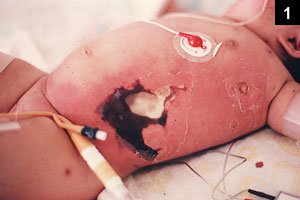
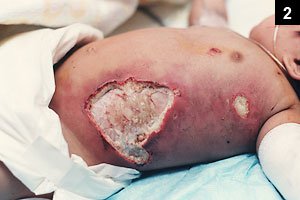
What’s Your Diagnosis?
- Sepsis
- Toxic shock syndrome
- Necrotizing fasciitis
- Severe varicella
Answer
The “most correct” answer is C, necrotizing fasciitis. Of course the patient was septic and probably had toxic shock syndrome as well, but the inability to surgically get ahead of the fasciitis is what leads to the inability to clear the infection with the septic consequences that followed. Antibiotics are important, but they will not do the job alone. Therefore, the surgeon needs to be very aggressive in emergently debriding the infected tissue.
This problem was discussed using another case in the June 2000 issue of Infectious Diseases in Children; however, with the widespread use of varicella vaccine nowadays, we rarely see this condition today. The varicella vaccine was licensed by the FDA in 1995, and recommended for all children aged 12 months and above. However, in 1980 when Dr. Cater’s case occurred, varicella was common and, as this case illustrates, sometimes had fatal consequences.
By 2000, when I first featured this condition, only about 50% of eligible children were immunized against varicella, largely due to lack of enthusiasm by medical providers as well as the misconception by both providers and parents that varicella was a minor childhood “rite of passage,” with relatively mild disease like the patient shown in figures 3 & 4, with the classic rash as shown in figure 5. As a result, in 2000 we were still seeing children being admitted with severe secondary infections such as the patient presented in that column, as shown in figures 6 & 7. That child was quickly taken to the operating room for wide debridement as shown in figures 8 & 9. About a month later, she is shown in figure 10, prior to grafting, with a good outcome. That patient had fasciitis due to group A strep, which is (was) by far most common. But as Dr. Cater’s case illustrates, Staphylococcus aureus was occasionally the cause, if not at least in the mix. Oftentimes, anaerobes such as Peptostreptococcus could be found as well, as was also the case in the patient presented.
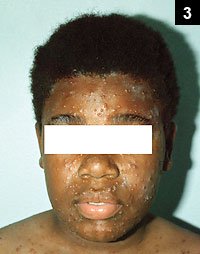
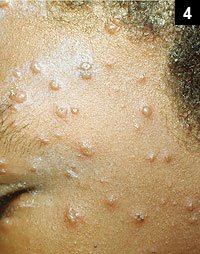
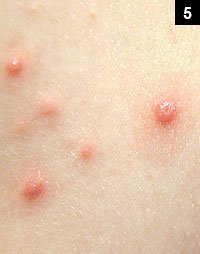
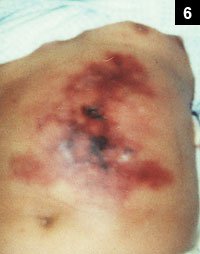
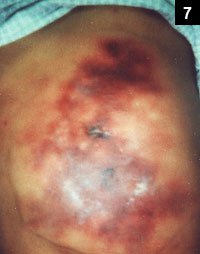
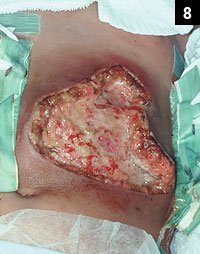
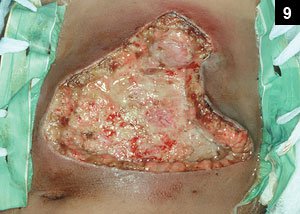
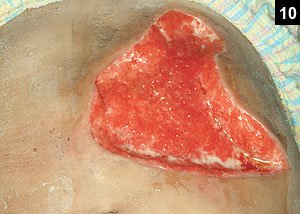
Other secondary infections may complicate varicella, as shown in figures 11 & 12 (from the Jim Bass collection), a child with bullous varicella, usually due to Staph aureus, and another child (figure 13 & 14 from Dr. Cater’s collection) with an unusual case of bullous varicella complicated by group A strep infection in the healing stage.
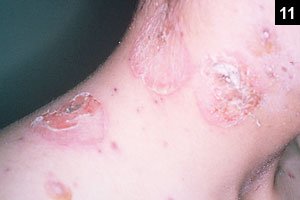
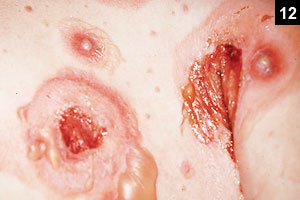
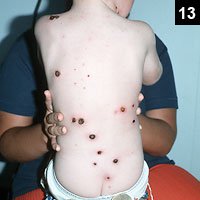

Lastly, in addition to the suppurative complications of varicella, children would occasionally be admitted to the hospital for evaluation of non-suppurative neurologic complications, such as transverse myelitis, cerebellar ataxia and encephalitis, plus the often fatal complication of varicella in the immunocompromised. Fortunately, all these problems are much less common now because of the improved compliance with the recommendation for the routine use of varicella vaccine.
I would like to sincerely thank Dr. Cater (figure 15) for contributing this case.

Columnist Comments: Let’s hope that varicella, along with its complications, continues to fade into the history books. Along the same lines, in May 2008 the CDC “officially” recommended the shingles vaccine (Zostavax) for adults aged 60 years and older. I’m overdue for mine, but plan to get it as soon as possible.
I hope your New Year is off to a good start. Many challenges lay ahead for us all. However, there are always opportunities, and one is Chair of our pediatric department at Scott & White / Texas A & M University College of Medicine. If interested, just e-mail me at jhbrien@aol.com, and I will fill you in. Of course if you took the job you would have to work with me; however, since I have no important title or position, it would be almost as if I were not even there. So, what have you got to lose?
A bitter-sweet holiday tradition
As a pediatrician, I have taken special notice over the last several years of many emotional, surprise reunions of “soldier parents” and their unsuspecting children, as they return from Iraq or Afghanistan, usually shown on various TV news programs and concentrated around the holiday season. These happy events usually take place at the child’s school, but can be almost anywhere. The stories are understandably accompanied by tears of joy by all (sometimes myself included). It’s only natural to enjoy seeing these precious moments.
However, at the same time, it always makes me sad to think of the 4,763 military personnel whose families, many of whom are watching these programs, will never have that happy reunion (4,209 killed in Iraq and 556 in Afghanistan as of this writing). I’m not suggesting that the media stop producing stories of these reunions to supplement their news shows, but we should also think of those families who may see it and have their wounds reopened and their grief greatly exacerbated. Sometimes the price of our entertainment comes a bit higher than we might realize. Perhaps during wartime, these reunions should remain a private matter for family and friends. Just something to think about.
Remember the 43rd Annual USPS (Uniformed Services Pediatric Seminar) in Indianapolis, Indiana, March 8 – 11, 2009. Go on line to the AAP website to find out more.
Editor’s Note: This case was donated by Michael W. Cater, MD, who practices general pediatrics in Tustin, California, and the Children’s Hospital of Orange County, California. Dr. Cater is a 1969 graduate of Loma Linda University School of Medicine and the Pediatric Residency at The University of California at Irvine in 1972. Dr. Cater then spent time in the U.S. Army Medical Corps with duty in Okinawa, Japan, from 1973–1974. He has been in Tustin, CA, since 1975.
